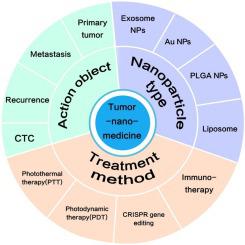当前位置:
X-MOL 学术
›
Nano Today
›
论文详情
Our official English website, www.x-mol.net, welcomes your
feedback! (Note: you will need to create a separate account there.)
Nanomedicines inhibiting tumor metastasis and recurrence and their clinical applications
Nano Today ( IF 13.2 ) Pub Date : 2020-11-20 , DOI: 10.1016/j.nantod.2020.101004 Xiangyi Kong , Ran Cheng , Jing Wang , Yi Fang , Kuo Chu Hwang
Nano Today ( IF 13.2 ) Pub Date : 2020-11-20 , DOI: 10.1016/j.nantod.2020.101004 Xiangyi Kong , Ran Cheng , Jing Wang , Yi Fang , Kuo Chu Hwang

|
Tumor metastasis and recurrence is one of the biggest problems in curing cancers. Due to the difficulty in complete removal of the primary tumor in traditional surgeries and the poor drug delivery efficiency of traditional chemotherapy, the residual tumor cells/tissues may further develop and result in tumor recurrence and/or distant metastasis. Nanoparticles with targeting probes and payload chemo-drugs are expected to conquer this problem, because they can efficiently accumulate at tumor sites to effectively inhibit the proliferation and metastasis of the primary tumor cells by themselves or via combination with other therapies, such as photothermal therapy, photodynamic therapy, chemotherapy, gene silencing, gene editing, etc. Meanwhile, they can also capture circulating tumor cells (CTCs), concentrate in targeted organs/lymph nodes that were invaded by metastatic tumor cells, and inhibit tumor metastasis and recurrence. From material science point of view, the functions of nanomedicines could be roughly divided into different categories, such as serving as nanocarriers for delivery of theranostic probes/chemotherapy drugs, as image contrast enhancers/radiosensitizers, diagnostic agents, or therapeutic agents. From a disease point view, tumor treatment can be roughly divided into different stages, including diagnosis, destruction of primary tumors, prevention of metastasis/recurrence, and clinical applications. In this paper, we review the use of nanomaterials in the treatment of tumors with a focus on those related to the inhibition of tumor metastasis/recurrence as well as clinical applications. We analyze the mechanisms and methods of using functional nanoparticles to destroy primary tumors and explore the abilities of functional nanoparticles on the inhibition of growth, spread, and recurrence of metastatic tumors. We also summarize the literature reported ongoing oncological trials in clinics using nanomedicines. Finally, we offer analysis and an outlook on the current research status, and highlight challenges and perspectives for the future development of nanomedicines.
中文翻译:

抑制肿瘤转移和复发的纳米药物及其临床应用
肿瘤转移和复发是治疗癌症的最大问题之一。由于传统手术难以彻底切除原发肿瘤,且传统化疗的药物输送效率较差,残留的肿瘤细胞/组织可能进一步发展,导致肿瘤复发和/或远处转移。具有靶向探针和有效负载化学药物的纳米颗粒有望克服这个问题,因为它们可以有效地在肿瘤部位积聚,从而通过自身或与其他疗法(例如光热疗法)组合来有效抑制原发性肿瘤细胞的增殖和转移。光动力疗法、化疗、基因沉默、基因编辑等。同时,它们还可以捕获循环肿瘤细胞(CTC),集中到转移性肿瘤细胞侵袭的靶器官/淋巴结,抑制肿瘤转移和复发。从材料科学的角度来看,纳米药物的功能可以大致分为不同的类别,例如作为治疗诊断探针/化疗药物的纳米载体,作为图像对比增强剂/放射增敏剂、诊断剂或治疗剂。从疾病的角度来看,肿瘤治疗大致可分为不同阶段,包括诊断、破坏原发肿瘤、预防转移/复发和临床应用。在本文中,我们回顾了纳米材料在肿瘤治疗中的应用,重点关注与抑制肿瘤转移/复发相关的纳米材料及其临床应用。我们分析了功能性纳米粒子破坏原发性肿瘤的机制和方法,并探讨了功能性纳米粒子抑制转移性肿瘤生长、扩散和复发的能力。我们还总结了使用纳米药物在临床上正在进行的肿瘤学试验的文献报道。最后,我们对当前的研究现状进行了分析和展望,并强调了纳米医学未来发展的挑战和前景。
更新日期:2020-11-20
中文翻译:

抑制肿瘤转移和复发的纳米药物及其临床应用
肿瘤转移和复发是治疗癌症的最大问题之一。由于传统手术难以彻底切除原发肿瘤,且传统化疗的药物输送效率较差,残留的肿瘤细胞/组织可能进一步发展,导致肿瘤复发和/或远处转移。具有靶向探针和有效负载化学药物的纳米颗粒有望克服这个问题,因为它们可以有效地在肿瘤部位积聚,从而通过自身或与其他疗法(例如光热疗法)组合来有效抑制原发性肿瘤细胞的增殖和转移。光动力疗法、化疗、基因沉默、基因编辑等。同时,它们还可以捕获循环肿瘤细胞(CTC),集中到转移性肿瘤细胞侵袭的靶器官/淋巴结,抑制肿瘤转移和复发。从材料科学的角度来看,纳米药物的功能可以大致分为不同的类别,例如作为治疗诊断探针/化疗药物的纳米载体,作为图像对比增强剂/放射增敏剂、诊断剂或治疗剂。从疾病的角度来看,肿瘤治疗大致可分为不同阶段,包括诊断、破坏原发肿瘤、预防转移/复发和临床应用。在本文中,我们回顾了纳米材料在肿瘤治疗中的应用,重点关注与抑制肿瘤转移/复发相关的纳米材料及其临床应用。我们分析了功能性纳米粒子破坏原发性肿瘤的机制和方法,并探讨了功能性纳米粒子抑制转移性肿瘤生长、扩散和复发的能力。我们还总结了使用纳米药物在临床上正在进行的肿瘤学试验的文献报道。最后,我们对当前的研究现状进行了分析和展望,并强调了纳米医学未来发展的挑战和前景。











































 京公网安备 11010802027423号
京公网安备 11010802027423号